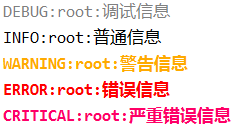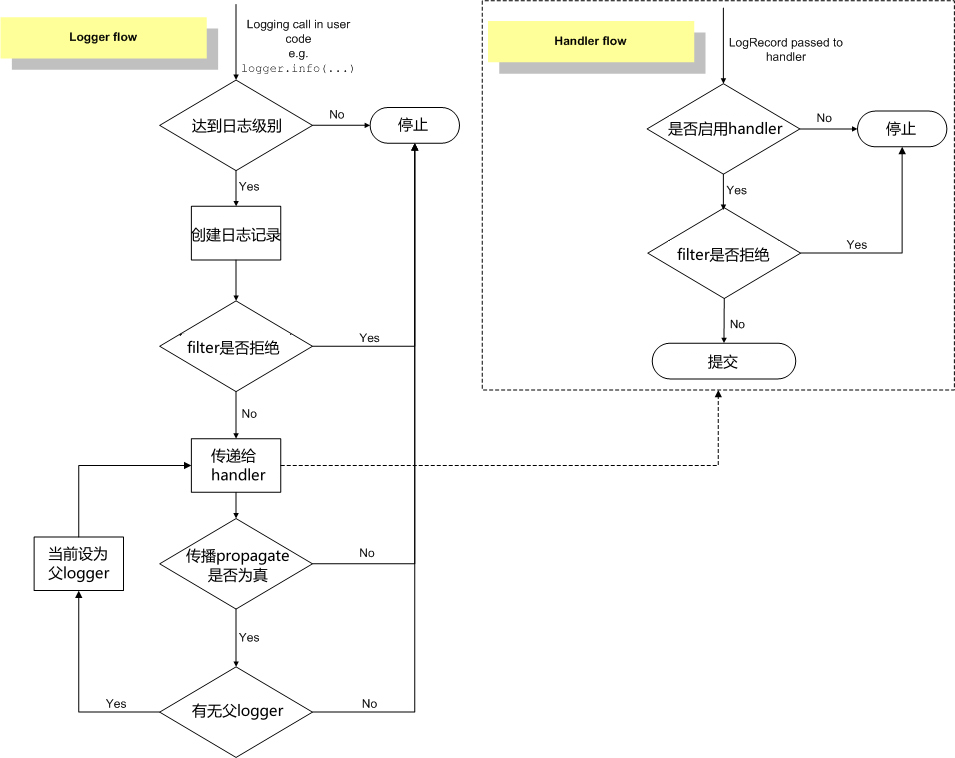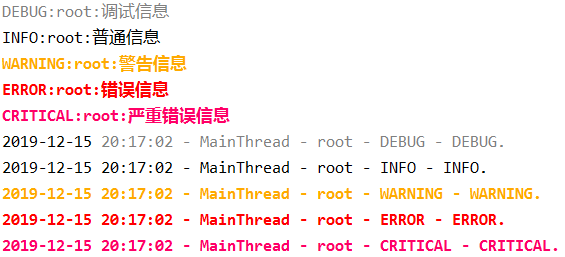简介
logging,Python内置库,实现了事件日志系统的函数与类。
loguru,第三方库,轻松记日志,一个函数搞定。

Eliot,一款强大的日志系统,告诉你:性能瓶颈、什么时候发生、谁调用了什么
初试
日志默认级别是 WARNING,所以 INFO 信息没有出现
import logging
logging.info('普通信息')
logging.warning('警告!')
# WARNING:root:警告!
记录 DEBUG 及以上级别日志,保存到 test.log
import logging
logging.basicConfig(filename='test.log', level=logging.DEBUG) # 记录DEBUG及以上级别日志
logging.debug('调试消息')
logging.info('普通消息')
logging.warning('警告消息')
logging.error('错误消息')
logging.critical('严重错误消息')
try:
1 / 0
except Exception as e:
logging.exception(e)
效果

日志基础教程
日志级别(以严重性递增)
| 级别 | 含义 |
|---|---|
| DEBUG | 调试信息,诊断问题时用 |
| INFO | 确认程序预期运行 |
| WARNING | 警告,如磁盘空间不足,程序仍进行 |
| ERROR | 错误,程序某些功能已不能正常进行 |
| CRITICAL | 严重错误,程序已不能继续进行 |
什么时候使用日志
| 任务 | 工具 |
|---|---|
| 结果显示在控制台的程序 | print() |
| 发生普通操作时提交事件报告(如:状态监控和错误调查) | logging.info(),需要详细输出时用 logging.debug() |
| 特殊运行时警告 | warnings.warn() 或 logging.warning() |
| 特殊运行时报告错误 | 引发异常 |
| 报告错误而不引发异常(如长时间运行的服务端进程) | logging.error(), logging.exception() 或 logging.critical() 分别适用于特定的错误及应用领域 |
消息格式
日志级别: 消息
import logging
logging.basicConfig(format='%(levelname)s: %(message)s', level=logging.DEBUG)
logging.debug('调试消息')
logging.info('普通消息')
logging.warning('警告消息')
logging.error('错误消息')
logging.critical('严重错误消息')
输出
DEBUG: 调试信息
INFO: 普通信息
WARNING: 警告信息
ERROR: 错误信息
CRITICAL: 严重错误信息
时间 消息
import logging
logging.basicConfig(format='%(asctime)s %(message)s', level=logging.DEBUG, datefmt='%Y-%m-%d %H:%M:%S')
logging.debug('调试消息')
logging.info('普通消息')
logging.warning('警告消息')
logging.error('错误消息')
logging.critical('严重错误消息')
输出
2020-07-21 15:00:00 调试消息
2020-07-21 15:00:00 普通消息
2020-07-21 15:00:00 警告消息
2020-07-21 15:00:00 错误消息
2020-07-21 15:00:00 严重错误消息
查看更多时间格式
日志属性
查看更多日志属性
import logging
# 时间
# logging.basicConfig(format='%(created)f %(message)s') # 被创建的时间,即 time.time()。1595317659.993426 xxx
# logging.basicConfig(format='%(asctime)s %(message)s', datefmt='%Y-%m-%d %H:%M:%S') # 供人查看的时间。2020-07-21 15:47:54 xxx
# logging.basicConfig(format='%(msecs)d %(message)s') # 创建时间毫秒部分。655 xxx
# logging.basicConfig(format='%(relativeCreated)d %(message)s') # 相对于 logging 加载的时间差。289 xxx
# 文件名
# logging.basicConfig(format='%(filename)s %(message)s') # 文件名。test.py xxx
# logging.basicConfig(format='%(module)s %(message)s') # 模块名。test xxx
# logging.basicConfig(format='%(name)s %(message)s') # 日志记录器名。root xxx
# logging.basicConfig(format='%(pathname)s %(message)s') # 完整路径名。D:/code/test/test.py xxx
logging.basicConfig(format='%(funcName)s %(message)s') # 函数名。f xxx
def f():
logging.warning('xxx')
f()
# 消息级别
# logging.basicConfig(format='%(levelname)s %(message)s') # 消息级别。WARNING xxx
# logging.basicConfig(format='%(levelno)s %(message)s') # 消息数字级别。30 xxx
# 行号
# logging.basicConfig(format='%(lineno)d %(message)s') # 消息数字级别。21 xxx
# 进程和线程
# logging.basicConfig(format='%(process)d %(message)s') # 进程ID。100240 xxx
# logging.basicConfig(format='%(processName)s %(message)s') # 进程名。MainProcess xxx
# logging.basicConfig(format='%(thread)d %(message)s') # 线程ID。131596 xxx
# logging.basicConfig(format='%(threadName)s %(message)s') # 线程名。MainThread xxx
logging.warning('xxx')
信息流程
logging库主要通过模块化的方法记录日志,主要模块有:
- Logger,记录器,提供直接调用的接口。
- Handler,处理器,将Logger创建的日志记录发送到合适的地方。
- Filter,过滤器,提供更精细的功能,用于确定要输出的日志记录。
- Formatter,格式器,指定最终输出的样式。

import logging
logger = logging.getLogger('test') # 创建logger
logger.setLevel(logging.DEBUG)
ch = logging.StreamHandler() # 创建handler
ch.setLevel(logging.DEBUG)
formatter = logging.Formatter('%(asctime)s - %(name)s - %(levelname)s - %(message)s', datefmt='%Y-%m-%d %H:%M:%S') # 创建formatter
ch.setFormatter(formatter) # 为handler设置formatter
logger.addHandler(ch) # 为logger添加handler
if __name__ == '__main__':
logger.debug('调试消息')
logger.info('普通消息')
logger.warning('警告消息')
logger.error('错误消息')
logger.critical('严重错误消息')

通过配置文件创建
实现配置和代码的分离,详细查阅日志记录配置
logging.ini
[loggers]
keys=root,test
[handlers]
keys=consoleHandler
[formatters]
keys=simpleFormatter
[logger_root]
level=DEBUG
handlers=consoleHandler
[logger_test]
level=DEBUG
handlers=consoleHandler
qualname=test
propagate=0
[handler_consoleHandler]
class=StreamHandler
level=DEBUG
formatter=simpleFormatter
args=(sys.stdout,)
[formatter_simpleFormatter]
format=%(asctime)s - %(name)s - %(levelname)s - %(message)s
datefmt=%Y-%m-%d %H:%M:%S
代码
import logging
import logging.config
logging.config.fileConfig('logging.ini') # 加载配置
logger = logging.getLogger('test') # 创建logger
if __name__ == '__main__':
logger.debug('调试消息')
logger.info('普通消息')
logger.warning('警告消息')
logger.error('错误消息')
logger.critical('严重错误消息')
PyCharm日志插件
安装方法:File → Settings → Plugins → Marketplace 搜 Ideolog → Install → Restart
test.log
DEBUG:root:调试信息
INFO:root:普通信息
WARNING:root:警告信息
ERROR:root:错误信息
CRITICAL:root:严重错误信息
2019-12-15 20:17:02 - MainThread - root - DEBUG - DEBUG.
2019-12-15 20:17:02 - MainThread - root - INFO - INFO.
2019-12-15 20:17:02 - MainThread - root - WARNING - WARNING.
2019-12-15 20:17:02 - MainThread - root - ERROR - ERROR.
2019-12-15 20:17:02 - MainThread - root - CRITICAL - CRITICAL.
设置格式
| Pattern | Action |
|---|---|
| \s*WARNING\s* | Highlight line |
| \s*ERROR\s* | Highlight line+stripe |
| \s*CRITICAL\s* | Highlight line+stripe |
| \s*DEBUG\s* | Highlight line |

显示效果

封装
参考 Python常用库 - logging日志库 的封装,不是很好用,无法显示是哪个文件调用的,所以也找不到错误的源头
使用方法:
from log import logger
logger.debug('调试消息')
logger.info('普通消息')
logger.warn('警告消息')
logger.error('错误消息')
logger.critical('严重错误消息')
log.py
import logging
from logging import handlers
class Logger:
__instance = None
def __new__(cls, *args, **kwargs):
if not cls.__instance:
cls.__instance = object.__new__(cls, *args, **kwargs)
return cls.__instance
def __init__(self):
# formater = logging.Formatter('%(message)s') # 只要原本信息
formater = logging.Formatter('%(asctime)s - %(levelname)s - %(message)s', datefmt='%Y-%m-%d %H:%M:%S') # 设置输出格式
self.logger = logging.getLogger('log') # 定义一个日志收集器
self.logger.setLevel(logging.INFO) # 设定级别
self.fileLogger = handlers.RotatingFileHandler("./test.log", maxBytes=5242880, backupCount=3,
encoding='utf-8') # 输出渠道一 - 文件形式
self.console = logging.StreamHandler() # 输出渠道二 - 控制台
self.console.setLevel(logging.INFO) # 控制台输出级别
self.console.setFormatter(formater) # 输出渠道对接输出格式
self.fileLogger.setFormatter(formater)
self.logger.addHandler(self.fileLogger) # 日志收集器对接输出渠道
self.logger.addHandler(self.console)
def debug(self, msg):
self.logger.debug(msg=msg)
def info(self, msg):
self.logger.info(msg=msg)
def warn(self, msg):
self.logger.warning(msg=msg)
def error(self, msg):
self.logger.error(msg=msg)
def critical(self, msg):
self.logger.critical(msg=msg)
def excepiton(self, msg):
self.logger.exception(msg=msg)
logger = Logger()
if __name__ == '__main__':
logger.debug('调试消息')
logger.info('普通消息')
logger.warn('警告消息')
logger.error('错误消息')
logger.critical('严重错误消息')
try:
1 / 0
except Exception as e:
logger.excepiton(e)
loguru入门
安装
pip install loguru
无需样板即可使用
from loguru import logger
logger.debug('调试消息')
logger.info('普通消息')
logger.warning('警告消息')
logger.error('错误消息')
logger.critical('严重错误消息')

推荐阅读:Python日志库loguru——轻松记日志,一个函数搞定
Eliot入门
安装
pip install eliot eliot-tree
import requests
from eliot import start_action, to_file
to_file(open("linkcheck.log", "w"))
def check_links(urls):
with start_action(action_type="check_links", urls=urls):
for url in urls:
try:
with start_action(action_type="download", url=url):
response = requests.get(url)
response.raise_for_status()
except Exception as e:
raise ValueError(str(e))
try:
check_links(["http://eliot.readthedocs.io", "http://nosuchurl"])
except ValueError:
print("Not all links were valid.")
linkcheck.log
{"urls": ["http://eliot.readthedocs.io", "http://nosuchurl"], "action_status": "started", "timestamp": 1595411823.472086, "task_uuid": "532571b5-59a1-4fe8-983b-ed35101c9dfc", "action_type": "check_links", "task_level": [1]}
{"url": "http://eliot.readthedocs.io", "action_status": "started", "timestamp": 1595411823.472086, "task_uuid": "532571b5-59a1-4fe8-983b-ed35101c9dfc", "action_type": "download", "task_level": [2, 1]}
{"action_status": "succeeded", "timestamp": 1595411823.726474, "task_uuid": "532571b5-59a1-4fe8-983b-ed35101c9dfc", "action_type": "download", "task_level": [2, 2]}
{"url": "http://nosuchurl", "action_status": "started", "timestamp": 1595411823.726474, "task_uuid": "532571b5-59a1-4fe8-983b-ed35101c9dfc", "action_type": "download", "task_level": [3, 1]}
{"errno": null, "exception": "requests.exceptions.ConnectionError", "reason": "HTTPConnectionPool(host='nosuchurl', port=80): Max retries exceeded with url: / (Caused by NewConnectionError('<urllib3.connection.HTTPConnection object at 0x000000000B398320>: Failed to establish a new connection: [Errno 11004] getaddrinfo failed',))", "action_status": "failed", "timestamp": 1595411826.2962916, "task_uuid": "532571b5-59a1-4fe8-983b-ed35101c9dfc", "action_type": "download", "task_level": [3, 2]}
{"exception": "builtins.ValueError", "reason": "HTTPConnectionPool(host='nosuchurl', port=80): Max retries exceeded with url: / (Caused by NewConnectionError('<urllib3.connection.HTTPConnection object at 0x000000000B398320>: Failed to establish a new connection: [Errno 11004] getaddrinfo failed',))", "action_status": "failed", "timestamp": 1595411826.2962916, "task_uuid": "532571b5-59a1-4fe8-983b-ed35101c9dfc", "action_type": "check_links", "task_level": [4]}
树状可视化
eliot-tree linkcheck.log
效果
b1cb58cf-2c2f-45c0-92b2-838ac00b20cc
└── check_links/1 ⇒ started
├── timestamp: 2017-10-27 20:42:47.206684
├── urls:
│ ├── 0: http://eliot.readthedocs.io
│ └── 1: http://nosuchurl
├── download/2/1 ⇒ started
│ ├── timestamp: 2017-10-27 20:42:47.206933
│ ├── url: http://eliot.readthedocs.io
│ └── download/2/2 ⇒ succeeded
│ └── timestamp: 2017-10-27 20:42:47.439203
├── download/3/1 ⇒ started
│ ├── timestamp: 2017-10-27 20:42:47.439412
│ ├── url: http://nosuchurl
│ └── download/3/2 ⇒ failed
│ ├── errno: None
│ ├── exception: requests.exceptions.ConnectionError
│ ├── reason: HTTPConnectionPool(host='nosuchurl', port=80): Max retries exceeded with url: / (Caused by NewConnec…
│ └── timestamp: 2017-10-27 20:42:47.457133
└── check_links/4 ⇒ failed
├── exception: builtins.ValueError
├── reason: HTTPConnectionPool(host='nosuchurl', port=80): Max retries exceeded with url: / (Caused by NewConnec…
└── timestamp: 2017-10-27 20:42:47.457332






















 1174
1174











 被折叠的 条评论
为什么被折叠?
被折叠的 条评论
为什么被折叠?










